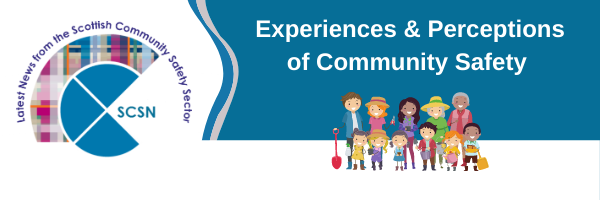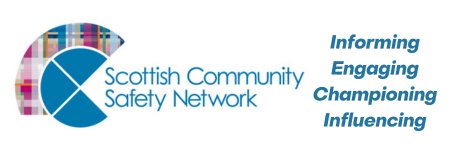
Today the Scottish Community Safety Network have published a significant piece of research. ‘Experiences and Perceptions of Community Safety in Scotland’, produced by Robyn Bailey, Social Researcher for the Scottish Government, was commissioned by SCSN as part of the Scottish Government’s analytical exchange programme. The research was launched at a webinar on 1st December with practitioners from across the community safety sector in Scotland.
SCSN have had a long-standing interest in what makes people safe; and a curiosity about the role that various factors, people and organisations play in creating safe communities. In February 2020 we found out we were successful in securing an analyst through the Scottish Government’s analytical exchange programme. The research that we are publishing today is the culmination of this work with Robyn Bailey during the summer months to better understand people’s experiences of safety throughout the life stages as well as understanding different communities’ experiences of safety. This project unpicks high level data about, and illustrates personal experiences of community safety, helping us to further our understanding of how to support safer communities in Scotland.
We hope this piece of work will help partners to further their work on prevention as well as influence their policy and practice to match this diversity in experiences of community safety. We will use it to influence our conversations about what makes a safe community and understanding how these things interact with one another to create inclusive, resilient and safe communities.
Key findings from the research include:
- Different groups feel safe and worry about crime to different degrees: Children and young adults, women, Minority Ethnic people, people with a disability, people in more deprived areas and in lower income households, people in urban areas and victims of crime generally feel less safe alone at night and worry about crime more in Scotland.
- Fear of crime is more apparent in particular groups such as minority ethnic people, LGBTQ communities and for women and girls. Fear of crime has an impact on wellbeing, the choices they make and can affect people’s experiences of life.
- There are major data gaps, especially around young children; trans and gender non-conforming people; lesbian, gay and bisexual people; specific minority ethnic groups in Scotland; and people with specific disabilities – as well as the need to understand experiences where there are intersections of these identities
- Groups may need tailored community safety strategies or responses from public services – some may benefit from neighbourhood schemes, or more interaction with police; and we also need to explore the root causes of feelings of safety and unsafety to be able to shift to more preventative approaches for better outcomes.
- Future research also needs to explore how these experiences have changed after COVID-19, e.g., older people, those with underlying health conditions and minority ethnic people are at a greater risk from the virus. In addition, those more susceptible to the virus may have their quality of life impacted more disproportionately due to policy measures such as social isolation, shielding and the resulting impact on loneliness and wellbeing.
Lorraine Gillies, Chief Officer of the Scottish Community Safety Network said that “We are delighted to be publishing this vital piece of work. It is essential that we design our community safety approaches and services for the benefit of ALL groups and communities. It was inspiring to hear participants at the launch event on 1st December reflect and discuss how community safety practitioners can work to embrace participative practice and pursue equality of experience for all within the field of community safety.”
Next steps
The publication of this research is the beginning of some new conversations between SCSN and community safety partnerships and with organisations that work closely with some of the communities outlined in the research. We will continue these conversations in 2021 to develop a richer understanding of these diverse experiences and what the response from public services and communities might be. Please get in touch with josh.box@scsn.org.uk if you would like to find out more and / or share your reflections on the research.
We have published a recording of the webinar launch which you can view here.
Download the research in full here.
Notes to editors:
1. The research comprised a rapid evidence review using online journal articles. Data was gathered and analysed from the Scottish Crime and Justice Survey (SCJS), the Scottish Household Survey (SHS), the Scottish Health Survey (SHeS), and Public Health Scotland (PHS). The research looks at reported feelings of safety, perceptions of neighbourhood issues, experiences of crime and worry about crime.
2. This research was launched at a webinar that took place on the 1st December 2020. Nearly 50 people attended from many different disciplines and guest speakers from external organisations shared their experiences of community safety in relation to children and young people, disabled people, women and girls and people experiencing homelessness.
